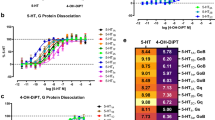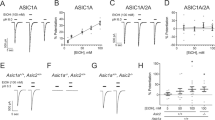Abstract
Rationale
Acid sensing ion channels (ASICs) are proton-gated ion channels located in the central and peripheral nervous systems. Of particular interest is ASIC1a, which is located in areas associated with fear and anxiety behaviors. Recent reports suggest a role for ASIC1a in preclinical models of fear conditioning and anxiety.
Objectives
The present experiments evaluated various ASIC inhibitors in preclinical models of autonomic and behavioral parameters of anxiety. In addition, neurochemical studies evaluated the effects of an ASIC inhibitor (A-317567) on neurotransmitter levels in the amygdala.
Results
In electrophysiological studies using hippocampal primary neuronal cultures, three ASIC inhibitors (PcTX-1, A-317567, and amiloride) produced concentration-dependent inhibition of acid-evoked currents. In the stress-induced hyperthermia model, acute administration of psalmotoxin 1 (PcTX-1; 10–56 ng, i.c.v.), A-317567 (0.1–1.0 mg/kg, i.p.), and amiloride (10–100 mg/kg, i.p.) prevented stress-induced elevations in core body temperature. In the four-plate test, acute treatment with PcTX-1 (10–56 ng, i.c.v.) and A-317567 (0.01–0.1 mg/kg, i.p.), but not amiloride (3–100 mg/kg, i.p.), produced dose-dependent and significant increases in the number of punished crossings relative to vehicle-treated animals. Additionally, PcTX-1 (56–178 ng, i.c.v.), A-317567 (0.1–10 mg/kg, i.p.), and amiloride (10–100 mg/kg, i.p.) lacked significant anxiolytic-like activity in the elevated zero maze. In neurochemical studies, an infusion of A-317567 (100 µM) into the amygdala significantly elevated the extracellular levels of GABA, but not glutamate, in this brain region.
Conclusions
These findings demonstrate that ASIC inhibition produces anxiolytic-like effects in some behavioral models and indicate a potential role for GABAergic mechanisms to underlie these anxiolytic-like effects.





Similar content being viewed by others
References
Ali A, Ahmad FJ, Pillai KK, Vohora D (2005) Amiloride protects against pentylenetetrazole-induced kindling in mice. Br J Pharmacol 145:880–884
Ali A, Pillai KP, Ahmad FJ, Dua Y, Vohora D (2006) Anticonvulsant effect of amiloride in pentetrazole-induced status epilepticus in mice. Pharmacol Rep 58:242–245
Aron C, Simon P, Larousse C, Boissier JR (1971) Evaluation of a rapid technique for detecting minor tranquilizers. Neuropharmacology 10:459–469
Borsini F, Lecci A, Volterra G, Meli A (1989) A model to measure anticipatory anxiety in mice. Psychopharmacology (Berl) 98:207–211
Brooks CM (1988) The history of thought concerning the hypothalamus and its functions. Brain Res Bull 20:657–667
Bruncko M, McClellan WJ (2003) Preparation of (isoquinolinylethenyl)- and (isoquinolinylcyclopropyl)naphthamidine urokinase inhibitors. United States of America
Charney DS (2003) Neuroanatomical circuits modulating fear and anxiety behaviors. Acta Psychiatr Scand 108:38–50
Chen X, Kalbacher H, Grunder S (2005) The tarantula toxin psalmotoxin 1 inhibits acid-sensing ion channel (ASIC) 1a by increasing its apparent H+ affinity. J Gen Physiol 126:71–79
Chen X, Kalbacher H, Grunder S (2006) Interaction of acid-sensing ion channel (ASIC) 1 with the tarantula toxin psalmotoxin 1 is state dependent. J Gen Physiol 127:267–276
Coryell MW, Ziemann AE, Westmoreland PJ, Haenfler JM, Kurjakovic Z, Zha XM, Price M, Schnizler MK, Wemmie JA (2007) Targeting ASIC1a reduces innate fear and alters neuronal activity in the fear circuit. Biol Psychiatry 62:1140–1148
Delgado MR, Olsson A, Phelps EA (2006) Extending animal models of fear conditioning to humans. Biol Psychol 73:39–48
Dimicco JA, Zaretsky DV (2007) The dorsomedial hypothalamus: a new player in thermoregulation. Am J Physiol Regul Integr Comp Physiol 292:R47–63
DiMicco JA, Sarkar S, Zaretskaia MV, Zaretsky DV (2006) Stress-induced cardiac stimulation and fever: common hypothalamic origins and brainstem mechanisms. Auton Neurosci 126–127:106–119
DSM-IV-TR (2000) Diagnostic and statistical manual of mental disorders (DSM-IV-TR), 4th edn (text revision). American Psychiatric Association
Dubé GR, Lehto SG, Breese NM, Baker SJ, Wang X, Matulenko MA, Honoré P, Stewart AO, Moreland RB, Brioni JD (2005) Electrophysiological and in vivo characterization of A-317567, a novel blocker of acid sensing ion channels. Pain 117:88–96
DuPont RL, Rice DP, Miller LS, Shiraki SS, Rowland CR, Harwood HJ (1996) Economic costs of anxiety disorders. Anxiety 2:167–172
Escoubas P, De Weille JR, Lecoq A, Diochot S, Waldmann R, Champigny G, Moinier D, Menez A, Lazdunski M (2000) Isolation of a tarantula toxin specific for a class of proton-gated Na+ channels. J Biol Chem 275:25116–25121
Goodman WK (2004) Selecting pharmacotherapy for generalized anxiety disorder. J Clin Psychiatry 65(Suppl 13):8–13
Greenberg PE, Sisitsky T, Kessler RC, Finkelstein SN, Berndt ER, Davidson JR, Ballenger JC, Fyer AJ (1999) The economic burden of anxiety disorders in the 1990s. J Clin Psychiatry 60:427–435
Gregorian RS, Golden KA, Bahce A, Goodman C, Kwong WJ, Khan ZM (2002) Antidepressant-induced sexual dysfunction. Ann Pharmacother 36:1577–1589
Greist J, McNamara RK, Mallinckrodt CH, Rayamajhi JN, Raskin J (2004) Incidence and duration of antidepressant-induced nausea: duloxetine compared with paroxetine and fluoxetine. Clin Ther 26:1446–1455
Ho IK, Yu S (1991) Effects of barbiturates on GABA system: comparison to alcohol and benzodiazepines. Keio J Med 40:183–186
Khong E, Sim MG, Hulse G (2004) Benzodiazepine dependence. Aust Fam Physician 33:923–926
Lecci A, Borsini F, Volterra G, Meli A (1990) Pharmacological validation of a novel animal model of anticipatory anxiety in mice. Psychopharmacology (Berl) 101:255–261
McGahan MC, Bentley PJ (1982) Stimulation of transepithelial sodium and chloride transport by ascorbic acid. Induction of Na+ channels is inhibited by amiloride. Biochim Biophys Acta 689:385–392
Nemeroff CB (2003) The role of GABA in the pathophysiology and treatment of anxiety disorders. Psychopharmacol Bull 37:133–146
Nestoros JN (1984) Gabaergic mechanisms and anxiety: an overview and a new neurophysiological model. Can J Psychiatry 29:520–529
Olivier B, Zethof T, Pattij T, van Boogaert M, van Oorschot R, Leahy C, Oosting R, Bouwknecht A, Veening J, van der Gugten J, Groenink L (2003) Stress-induced hyperthermia and anxiety: pharmacological validation. Eur J Pharmacol 463:117–132
Page AJ, Brierley SM, Martin CM, Martinez-Salgado C, Wemmie JA, Brennan TJ, Symonds E, Omari T, Lewin GR, Welsh MJ, Blackshaw LA (2004) The ion channel ASIC1 contributes to visceral but not cutaneous mechanoreceptor function. Gastroenterology 127:1739–1747
Paxinos G, Watson C (1986) Rat brain in stereotactic coordinates, second edn. Academic, New York
Ring RH, Malberg JE, Potestio L, Ping J, Boikess S, Luo B, Schechter LE, Rizzo S, Rahman Z, Rosenzweig-Lipson S (2006) Anxiolytic-like activity of oxytocin in male mice: behavioral and autonomic evidence, therapeutic implications. Psychopharmacology (Berl) 185:218–225
Ripoll N, Hascoet M, Bourin M (2006) The four-plates test: anxiolytic or analgesic paradigm. Prog Neuropsychopharmacol Biol Psychiatry 30:873–880
Rothschild AJ (2000) Sexual side effects of antidepressants. J Clin Psychiatry 61(Suppl 11):28–36
Salinas M, Rash LD, Baron A, Lambeau G, Escoubas P, Lazdunski M (2006) The receptor site of the spider toxin PcTx1 on the proton-gated cation channel ASIC1a. J Physiol 570:339–354
Schechter LE, Lin Q, Smith DL, Zhang G, Shan Q, Platt B, Brandt MR, Dawson LA, Cole D, Bernotas R, Robichaud A, Rosenzweig-Lipson S, Beyer CE (2008) Neuropharmacological profile of novel and selective 5-HT6 receptor agonists: WAY-181187 and WAY-208466. Neuropsychopharmacology 33:1323–1335
Shepherd JK, Grewal SS, Fletcher A, Bill DJ, Dourish CT (1994) Behavioural and pharmacological characterisation of the elevated “zero-maze” as an animal model of anxiety. Psychopharmacology (Berl) 116:56–64
Sim MG, Khong E, Wain TD (2007) The prescribing dilemma of benzodiazepines. Aust Fam Physician 36:923–926
Wagstaff AJ, Cheer SM, Matheson AJ, Ormrod D, Goa KL (2002) Paroxetine: an update of its use in psychiatric disorders in adults. Drugs 62:655–703
Waldmann R (2001) Proton-gated cation channels—neuronal acid sensors in the central and peripheral nervous system. Adv Exp Med Biol 502:293–304
Waldmann R, Lazdunski M (1998) H(+)-gated cation channels: neuronal acid sensors in the NaC/DEG family of ion channels. Curr Opin Neurobiol 8:418–424
Waldmann R, Champigny G, Bassilana F, Heurteaux C, Lazdunski M (1997) A proton-gated cation channel involved in acid-sensing. Nature 386:173–177
Wemmie JA, Chen J, Askwith CC, Hruska-Hageman AM, Price MP, Nolan BC, Yoder PG, Lamani E, Hoshi T, Freeman JH Jr., Welsh MJ (2002) The acid-activated ion channel ASIC contributes to synaptic plasticity, learning, and memory. Neuron 34:463–477
Wemmie JA, Askwith CC, Lamani E, Cassell MD, Freeman JH Jr., Welsh MJ (2003) Acid-sensing ion channel 1 is localized in brain regions with high synaptic density and contributes to fear conditioning. J Neurosci 23:5496–5502
Wemmie JA, Coryell MW, Askwith CC, Lamani E, Leonard AS, Sigmund CD, Welsh MJ (2004) Overexpression of acid-sensing ion channel 1a in transgenic mice increases acquired fear-related behavior. Proc Natl Acad Sci USA 101:3621–3626
Xiong Z-G, Zhu X-M, Chu X-P, Minami M, Hey J, Wei W-L, MacDonald JF, Wemmie JA, Price MP, Welsh MJ, Simon RP (2004) Neuroprotection in ischemia: blocking calcium-permeable acid-sensing ion channels. Cell 118:687–698
Zha XM, Wemmie JA, Green SH, Welsh MJ (2006) Acid-sensing ion channel 1a is a postsynaptic proton receptor that affects the density of dendritic spines. Proc Natl Acad Sci USA 103:16556–16561
Acknowledgements
The authors would like to thank Juan Mercado and Tony Silverio for their exceptional technical contributions.
Financial Disclosure Statement
The authors declare that, except for income received from primary employer, no financial compensation has been received from any individual or corporation over the past 3 years for research or professional services. Thus, there are no personal financial holdings that could be perceived as constituting a potential conflict of interest.
Author information
Authors and Affiliations
Corresponding author
Rights and permissions
About this article
Cite this article
Dwyer, J.M., Rizzo, S.J.S., Neal, S.J. et al. Acid sensing ion channel (ASIC) inhibitors exhibit anxiolytic-like activity in preclinical pharmacological models. Psychopharmacology 203, 41–52 (2009). https://doi.org/10.1007/s00213-008-1373-7
Received:
Accepted:
Published:
Issue Date:
DOI: https://doi.org/10.1007/s00213-008-1373-7




